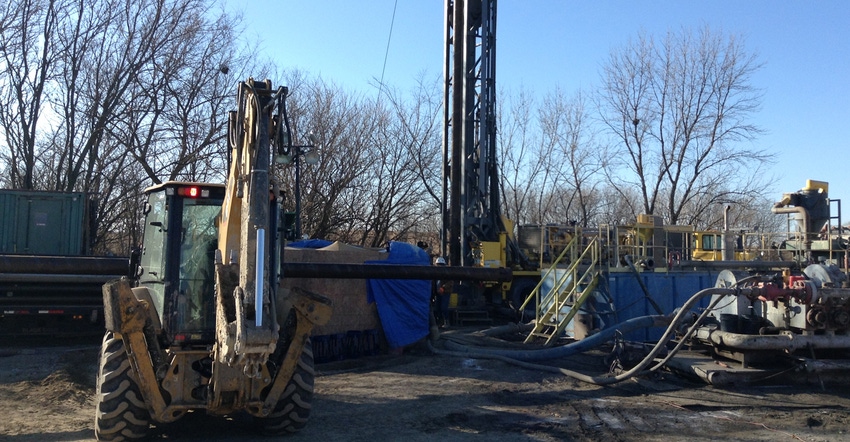May 18, 2018

Helping build communities from the ground up is something USDA programs have been doing across rural America for more than 80 years. Each year USDA Rural Development loans and grants provide housing opportunities for thousands of rural Iowans while also supporting a wide variety of job-creation and community-improvement projects and activities.
“Our rural communities are the heartbeat of Iowa and bring to the state a workforce dedicated to innovation and an entrepreneurial spirit,” says Tim Helmbrecht, USDA Rural Development acting state director in Iowa. “USDA Rural Development is focused on making infrastructure improvements in rural America, enhancing strategic partnerships, and embracing innovation to continue to increase economic opportunity and create jobs in rural communities and areas.”
The community of Walnut, population 785, in Pottawattamie County in western Iowa, was relying on a 47-year-old well to provide water to it residents and businesses after its second well, which was more than 100 years old, collapsed in May 2015.
Big decisions for small community
“We take great pride in the quality of our water,” says Gene Larsen, mayor of Walnut. “Around 15 years ago community leaders made a good decision to build a new water treatment plant. When our second well failed, we had some tough decisions to make, as it did not look like we could afford to dig a new well.”
Despite the financial constraints, the community decided it needed to move forward with the well project, and a new 2,400-foot well was drilled that tapped into the Jordan Aquifer. The new well began providing water to the community in late April.
 GOOD WATER: Gene Larsen, mayor of Walnut, says his community takes great pride in the quality of the water it provides to its 785 residents.
GOOD WATER: Gene Larsen, mayor of Walnut, says his community takes great pride in the quality of the water it provides to its 785 residents.

“Our wells have to be some of the deepest in the state to reach the aquifer,” Larsen says. “We fully anticipate this new well will serve our community for many generations to come. That is our job in local government.”
USDA provided a $1.3 million loan to assist with this well-replacement project. Total cost of the project came in around $1.9 million, with other funding coming from a Community Development Block Grant administered by the Iowa Economic Development Authority and the Metropolitan Area Planning Agency, as well as a grant from the Iowa West Foundation.
Partnership makes it possible
“This project would not have been possible without a team of great partners,” Larsen says. “Everyone we worked with on the project — the engineers, hydrologists, contractors and USDA staff — showed amazing professionalism and knowledge,” he adds. “This has been a large project for our community, and I especially want to thank city clerk Terri Abel for all that she did to keep the project going.”
 HELPING HAND: Drilling a new well is a big expense for a small town. Financial assistance from USDA makes providing water to residents a reality.
HELPING HAND: Drilling a new well is a big expense for a small town. Financial assistance from USDA makes providing water to residents a reality.

“Ultimately, long-term targeted investment in rural infrastructure will mean more jobs in rural America, access to capital for rural communities, more commerce and international trade, accelerated new startup small businesses, and entrepreneurial innovations,” Helmbrecht says. “However, more needs to be done to help rebuild rural America’s infrastructure, and USDA has made investing in these areas a priority.”
Included in the fiscal year 2018 budget passed by Congress was the investment of $600 million to expand broadband in rural communities across the country. This funding is part of proposed legislation that would use $50 billion in federal investments to stimulate at least $1.5 trillion in rural infrastructure investment during the next decade.
Expanding access to broadband
In recent years, USDA’s broadband program has been used to assist more than 15 projects across the state through $110 million in loans and grants. Last year Western Iowa Telecom received a $24.8 million loan for an extensive fiber-to-the-premise project in northwest Iowa.
“We are working diligently to ensure these new broadband funds are used in the best way possible to improve e-connectivity and access for as many rural homes, businesses, farms, schools and health care facilities as possible,” Helmbrecht says. “USDA is pursuing an ambitious agenda to rebuild America’s infrastructure, including a special emphasis on rural communities.”
USDA’s recent investments into rural Iowa have helped rural Iowa families and individuals in purchasing homes, provided rental assistance to residents living in USDA-financed apartments, assisted rural businesses with expansion and job-creation initiatives, and supported communities in efforts to improve a variety of services to their residents.
“These types of investments are the result of strong partnerships that USDA has formed over the years with local business and civic leaders,” Helmbrecht says. “Together, we can ensure that USDA investments in rural infrastructure will create jobs, expand economic opportunities and help ensure that rural communities continue to be great places to live, work, start a business and raise a family.”
Leach is public information coordinator with USDA Rural Development in Iowa.
About the Author(s)
You May Also Like




